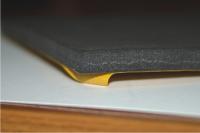Polyethylene
The polyethylene (PE), usually a closed cell foam but there are some exceptions with an semi-open cell. These cells are inert and do not produce bacteria and fungus, with a good air, water stagnancy, and good thermal, acoustic and of impact insulation.
They are divided in two groups according the production process and you can see the differences in the visual aspects (surface and cells)
- Physical Cross-linked PE
- Chemical Cross-linked PE
There are also some other items to have in consideration like:
- Fire resistance
- Compression
- Shape (roll or plate)
They are used when you need a lower cost to compete with more expensive materials like EPDM or PVC.
The main application is insulation (thermal and acoustic) but they also used as seals. They have a good performance when the materail is not liable to movements (Ex: seal in a door). Normally the material never recovers the initial shape when you compress it during a long period.
The desity goes from 23 up to 400 Kg/m3.
